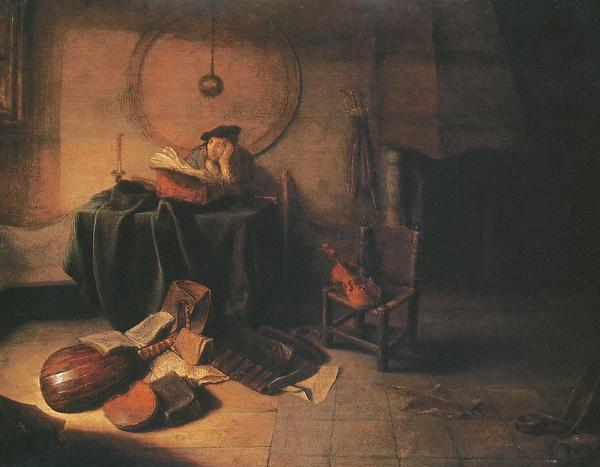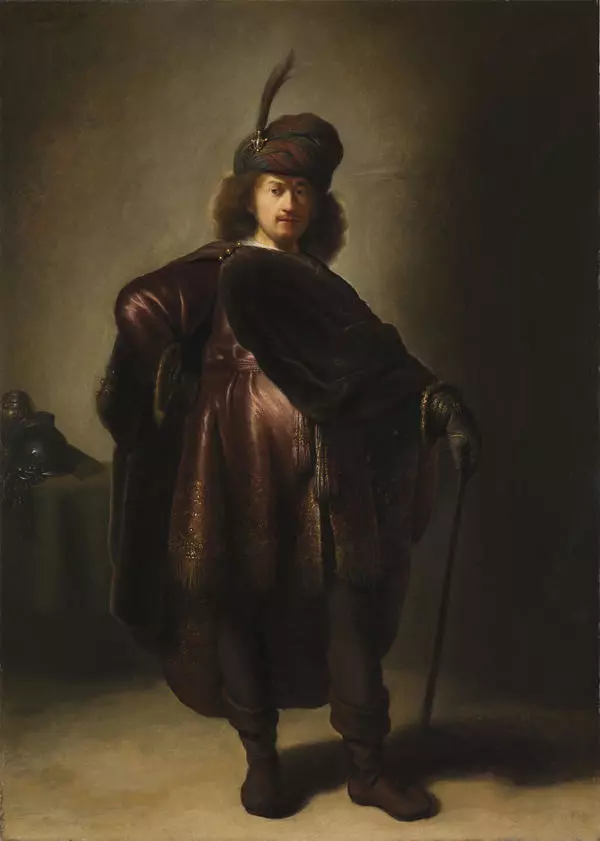In the antique and medieval medicine, the fate was determined by 4 temperaments: sanguine, phlegmatic, choleric, and melancholic. A special contribution into the study of the latter was made by Heinrich Cornelius Agrippa von Nettesheim – a physician and alchemist from the Holy Roman Empire. He formulated the symptoms of melancholy and determined the 3 levels of talents typical for this characteristic: in crafts and art, in science and policy, in religion and prophecy.
One can get an idea of the image of the first type of melancholy from the print under the same name engraved on copper by Albrecht Dürer – a German artist and wood engraver.
Isaac de Jouderville told us about the disease of the second type with oil on wood. On his painting Melancholia Secunda, the painter and graphic artist showed a scientist’s study. Yellow and red sunrays from the window suggest that it is a dawn of sunset. The lower left and upper right corners of the composition are shrouded in deep shadows.
The trend of that time was to attach an allegoric meaning to each detail of the interior. For example, there is only one piece of each type of furniture. It suggests that the character on the painting is lonely in both everyday life and in his researches.
As to the other objects, the spherical pendulum signified irrevocable regeneration of the world. The circle on the wall symbolized the presence of the divine at each point of the universe. Together, the elements of the décor formed the image of Saturn – the planet and the god, which allegedly protected melancholic persons and those engaged in unraveling mysteries.
In his emblematic anthology of the 14th century, Theodore Beza, a poet and reformer from Switzerland, wrote about the man as the center of macrocosm: “wherever you go, the heaven will be always same far”.
The candle, in its turn, symbolized the perishable nature of a human body and the brevity of life. A sword is an allegory of the will to glory and power. However, the weapon is hanging idle what speaks of the man’s rejection of active existence and competitive struggle. Massive books and musical instruments are scattered over the furniture and the floor hinting at the disappointment in studies and creative work.
Nevertheless, the young man is not frustrated, but switched over to more important questions of being. It is apparent from his contemplative posture and look into the distance.
The common belief is that Isaac de Jouderville was one of the debut pupils in the studio of Rembrandt Harmenszoon van Rijn. In the opinion of art experts, the pupil was so talented that even helped his teacher to paint heads and the environment. Moreover, a few canvases created by him were attributed to the celebrated master.
The influence of the pedagogue can be also traced on exhibit Scientist in His Study: by flowing lines and soft lighting.
One can get an idea of the image of the first type of melancholy from the print under the same name engraved on copper by Albrecht Dürer – a German artist and wood engraver.
Isaac de Jouderville told us about the disease of the second type with oil on wood. On his painting Melancholia Secunda, the painter and graphic artist showed a scientist’s study. Yellow and red sunrays from the window suggest that it is a dawn of sunset. The lower left and upper right corners of the composition are shrouded in deep shadows.
The trend of that time was to attach an allegoric meaning to each detail of the interior. For example, there is only one piece of each type of furniture. It suggests that the character on the painting is lonely in both everyday life and in his researches.
As to the other objects, the spherical pendulum signified irrevocable regeneration of the world. The circle on the wall symbolized the presence of the divine at each point of the universe. Together, the elements of the décor formed the image of Saturn – the planet and the god, which allegedly protected melancholic persons and those engaged in unraveling mysteries.
In his emblematic anthology of the 14th century, Theodore Beza, a poet and reformer from Switzerland, wrote about the man as the center of macrocosm: “wherever you go, the heaven will be always same far”.
The candle, in its turn, symbolized the perishable nature of a human body and the brevity of life. A sword is an allegory of the will to glory and power. However, the weapon is hanging idle what speaks of the man’s rejection of active existence and competitive struggle. Massive books and musical instruments are scattered over the furniture and the floor hinting at the disappointment in studies and creative work.
Nevertheless, the young man is not frustrated, but switched over to more important questions of being. It is apparent from his contemplative posture and look into the distance.
The common belief is that Isaac de Jouderville was one of the debut pupils in the studio of Rembrandt Harmenszoon van Rijn. In the opinion of art experts, the pupil was so talented that even helped his teacher to paint heads and the environment. Moreover, a few canvases created by him were attributed to the celebrated master.
The influence of the pedagogue can be also traced on exhibit Scientist in His Study: by flowing lines and soft lighting.




